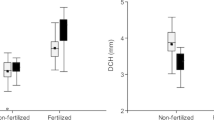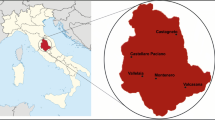Abstract
The quality of seedlings colonized by Tuber melanosporum is one of the main factors that contributes to the success or failure of a truffle crop. Truffle cultivation has quickly grown in European countries and elsewhere, so a commonly shared seedling evaluation method is needed. Five evaluation methods are currently published in the literature: three are used in Spain and two in France and Italy. Although all estimate the percentage colonization by T. melanosporum mycorrhizae, they do it in different ways. Two methods also estimate total number of mycorrhizae per seedling. Most are destructive. In this work, ten batches of holm oak seedlings inoculated with T. melanosporum from two different nurseries were evaluated by means of the five methods noted above. Some similarity was detected between the percentages of T. melanosporum mycorrhizae estimated by each method but not in their ability to assess the suitability of each batch. We discuss the advantages and disadvantages for each method and suggest approaches to reach consensus within the truffle culture industry for certifying mycorrhizal colonization by T. melanosporum and seedling quality.



Similar content being viewed by others
References
Agerer R (2006) Fungal relationships and structural identity of their ectomycorrhizas. Mycol Prog 5:67–107
Agerer R, Rambold G (2004–2013) [first posted on 2004-06-01; most recent update: 2011-01-10]. DEEMY—an information system for characterization and determination of ectomycorrhizae. www.deemy.de – München, Germany
Bencivenga M (2013) Towards an European regulation on the quality of truffle mycorrhized seedlings. 1st International Congress of Trufficulture, Teruel
Bonito G, Trappe J, Donovan S, Vilgalys R (2011) The Asian black truffle Tuber indicum can form ectomycorrhizas with North American host plants and complete its life cycle in non-native soils. Fungal Ecol 4(1):83–93
Chevalier G, Grente J (1973) Propagation de la mycorrhization par la truffe a partir de racines excisées et plantules inseminatrices. Ann Rev Phytopathologie 5:317–318
Chevalier G, Grente J (1978) Application pratique de la symbiose ectomycorhizienne: Production a grande échelle de plantes mycorhizes par la truffe (Tuber melanosporum Vitt.). Mushroom Sci 10:483–505
Cocina L, Barriuso J, Martín M, Sánchez S (2013) A review of nurseries producing mycorrhizal plants in Spain and the world. I Congreso Internacional de Truficultura, Teruel
COUNCIL DIRECTIVE 1999/105/EC of 22 December 1999 on the marketing of forest reproductive material. Official Journal of the European Union. http://new.eur-lex.europa.eu/search.html?instInvStatus=ALL&or0=DTS%3D3,DTS%3D0&or1=DTT%3DL&DTN=0105&DTA=1999&qid=1384875181945&DTC=false&DTS_DOM=ALL&type=advanced&SUBDOM_INIT=ALL_ALL&DTS_SUBDOM=ALL_ALL. Accessed 18 November 2013
Fischer C, Colinas C (1996) Methodology for certification of Quercus ilex seedlings inoculated with Tuber melanosporum for commercial application. 1st International Conference on Mycorrhizae, Berkeley
Govi G, Bencivenga M, Granetti B, Pacioni G, Palenzona M, Tocci A, Zambonelli A (1995) Presentazione del metodo di valutazione delle piante micorrizate con funghi del gen. Tuber basato sulla caratterizzazione morfologica delle micorrize. Regioni: Piemonte, Lombardia, Veneto, Emilia Romagna, Marche, Toscana, Umbria, Lazio, Molise, Abruzzo. Bollettino Ufficiale Della Regione Toscana - n. 24 del 30.4.1996
Hall I, Brown G, Zambonelli A (2007) Taming the truffle. The history, lore and science of the ultimate mushroom, Timber
Iotti M, Piattoni F, Zambonelli A (2012) Techniques for host plant inoculation with truffles and other edible ectomycorrhizal mushrooms. In: Zambonelli A, Bonito GM (eds) Edible ectomycorrhizal mushrooms, current knowledge and future prospects. Soil Biology 34, Springer, Berlin, pp 145–161
Mabru D, Dupré C, Douet JP, Leroy P, Ravel C, Ricard JM, Medina B, Castroviejo M, Chevalier G (2001) Rapid molecular typing method for the reliable detection of Asiatic black truffle (Tuber indicum) in commercialized products: fruiting bodies and mycorrhizal seedlings. Mycorrhiza 11:89–94
Montgomery DC (2001) Design and analysis of experiments. Wiley, New York
Murat C, Zampieri E, Vizzini A, Bonfante P (2008) Is the Perigord black truffle threatened by an invasive species? We dread it and it has happened! New Phytol 178:699–702
Palazón C, Delgado I, Cartié G, Barriuso J, Esteban H (1999) Propuesta de un método de evaluación y control de calidad de planta (Quercus spp.) micorrizada con Tuber melanosporum Vittad., para la obtención, en España, de la etiqueta de certificación. 5º Congres International Science et Culture de la Truffe, Aix-en-Provence, pp 6.311–6.313
Paolocci F, Rubini A, Granetti B, Arcioni S (1997) Typing Tuber melanosporum and Chinese black truffle species by molecular markers. FEMS Micobiol Lett 153:255–260
Parladé J, De la Varga H, De Miguel AM, Sáez R, Pera J (2013) Quantification of extraradical mycelium of Tuber melanosporum in soils from truffle orchards in northern Spain. Mycorrhiza 23:99–106
Peñuelas J (1993) Calidad de la planta forestal para el plan de reforestación de tierras agrícolas. Montes 33:84–97
Pérez-Collazos E, Barriuso J, Sánchez S, Palazón C (2010) Molecular identification of truffles. Atti del 3º Congresso Internazionale di Spoleto sul Tartufo, Spoleto, pp 122–129
Pruett G, Bruhn J, Mihail J (2008) Temporal dynamics of ectomycorrhizal community composition on root systems of oak seedlings infected with Burgundy truffle. Mycol Res 112:1344–1354
Rauscher T, Agerer R, Chevalier G (1995) Ektomycorrhizen von Tuber melanosporum, Tuber mesentericum und Tuber rufum (Tuberales) an Corylus avellana L. Nova Hedwigia 61:281–322
Reyna S, Boronat T, Palomar E (2000) Control de calidad en la planta micorrizada con Tuber melanosporum Vitt. producida por viveros comerciales. Montes 61:17–24
Rocchi MBL, Sisti D, Giomaro G, Zambonelli A, Stalks V (1999) Statistical methods applied to a model of in vitro mycorrhization (Tilia platyphyllos Scop. × Tuber borchii Vittad.). Micol Ital 2:38–43
Sánchez S (2012) Ectomicorrizas en el cultivo de trufa negra: ecología, diversidad y gestión. Universidad de Zaragoza, Doctoral dissertation
Sisti D, Giomaro G, Marco R, Zambonelli A, Romagnoli E, Gregori G (2010) New perspectives in the quality control of Tuber infected plants. Atti del 3º Congresso Internazionale di Spoleto sul Tartufo, Spoleto, pp 679–687
SPSS (2012) IBM SPSS advanced statistics 21. IBM Corporation, Inc., New York
Suz LM, Martín MP, Colinas C (2006) Detection of Tuber melanosporum DNA in soil. FEMS Microbiol Let 254:251–257
Trouvelot A, Kough JL, Gianinazzi-Pearson V (1986) Mesure du taux de mycorhization ayant une signification fonctionnelle. In: Aspects physiologiques et génétiques des mycorhizes, Dijon, 1985. INRA (éd.). pp 217-221
Zambonelli A, Salomoni S, Pisi A (1993) Caratterizzazione anatomo-morfologica delle micorrize di Tuber spp. su Quercus pubescens Willd. Micol Ital 3:73–90
Acknowledgments
This work was supported by the INIA (Ministry of Science and Innovation, Spanish Government) within the project RTA 2010-00070-C02-01. The authors would like to thank the support of Domizia Donnini, Christine Fischer, Carlos Palazón, Santiago Reyna, Sergi García-Barreda, and Gerard Chevalier, for their insightful comments, and Luz Cocina, Jorge Lora, Afif Headly, Alessandra Zambonelli, and Randy Molina for an early revision of the manuscript. Finally, we are also very grateful to the owners of the nurseries for their generous help.
Author information
Authors and Affiliations
Corresponding author
Rights and permissions
About this article
Cite this article
Andrés-Alpuente, A., Sánchez, S., Martín, M. et al. Comparative analysis of different methods for evaluating quality of Quercus ilex seedlings inoculated with Tuber melanosporum . Mycorrhiza 24 (Suppl 1), 29–37 (2014). https://doi.org/10.1007/s00572-014-0563-x
Received:
Accepted:
Published:
Issue Date:
DOI: https://doi.org/10.1007/s00572-014-0563-x




